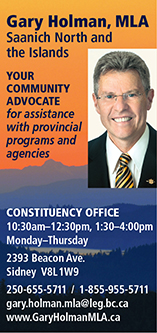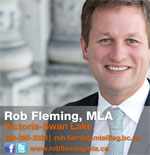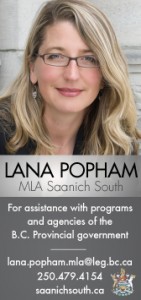Archive for August 2015

Where Old Clothes Go
A look at the world of recycling, reusing, and refusing, clothes
by Carole Pearson
Have you noticed the proliferation of thrift shops and donation drop-off bins around our community? The numerous charity thrift shops use the bins to collect the clothing that they use to generate revenue to support worthwhile community programs while helping shoppers stretch their dollars on clothing and household items.
Victoria’s Women in Need says its three retail shops help fund their $1 million a year operating budget. Beacon Community Services’ seven thrift stores raise $1.6 million in annual revenue and the Canadian Diabetic Association’s (CDA) Clothesline program, through its partnership with Value Village, brings in $10 million per year.
Last year in Vancouver and Victoria, The Salvation Army Thrift Store recycled 5.4 million pounds of cloth, 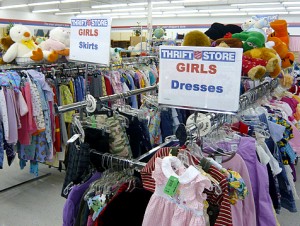 82,000 lbs of purses and belts, and 208,000 lbs of shoes – still too many people are throwing clothes that they feel may be unfit for re-sale, directly into the garbage.
82,000 lbs of purses and belts, and 208,000 lbs of shoes – still too many people are throwing clothes that they feel may be unfit for re-sale, directly into the garbage.
Eco Canada Textile Recycling says “Canada adds close to two million tonnes of textile waste to landfills each year.”
That’s just one of the problems with today’s cheap fashions. They are cheaply priced, they don’t last long in terms of wear or style, and they take effort to recycle. The low price tag of these fashions means consumers are buying and disposing of clothing in greater volumes than ever before – and far too many of these garments are winding up in our landfills.
What many people don’t know is thrift shops are not always the final destination for their used clothing nor are charities the only ones to profit from the discarded items. Andrew Brooks, author of Clothing Poverty, says, “As little as 10 to 30 percent of what is given to UK charities overall actually ends up being sold over-the-counter. It is a similar proportion in the US and Canada.”
While stained and worn clothing can’t be resold – it doesn’t necessarily have to be landfill either. Sonja Sharp’s article in the March, 2014 issue of Vice Magazine, “What Actually Happens to Donated Clothes,” states, “Of the roughly two million tons of used clothing Americans recycle each year, less than half is ever worn again: 30 percent is cut up for use as industrial rags, and another 20 percent is shredded for couch stuffing and home insulation.”
Entire industries have developed within the used apparel trade such as clothing recyclers or textile merchants, rag graders, and fibre buyers. The United Nations Comtrade Database shows exports of $185 million (2013) by Canada’s top 10 used clothing exporters. If these did not exist, one can only try to imagine how to manage this surfeit of unwanted clothing, besides stuffing landfills to capacity.
Clothing recyclers collect second-hand clothing donations by the truckload. At the warehouse, items are sorted and graded and then compressed into 100-pound bales and priced according to the contents. Most of the buyers are used clothing traders in Africa, the Indian sub-continent, and Latin America.
Speaking with The Guardian’s Marc Gunther, US-based Community Recycling president Ira Baseman “unapologetically admits that his company is a for-profit business.”
“We’re not asking for donations,” he explains. “We don’t use the D-word. It’s recycling, it’s re-use. People don’t object when for-profit companies recycle newspapers, bottles or cans,” he notes. “Why should clothes or shoes be different?”
So, instead of tossing that stained or torn shirt or blanket into the garbage, why not donate it to the Salvation Army or Value Village where it can continue to provide some good for community.
-30-
More from the Salvation Army:
Once items are collected from donation bins they are sent to a Distribution and Recycling Centre or directly to a local Thrift Store. Items are then sorted and placed on the floor.
The Salvation Army Thrift Store often receives donated clothing that cannot be sold in stores because it is torn, stained and/or overly worn. The Salvation Army Thrift Store is still able to generate funds from these clothing donations and divert them from local landfills by selling them to cloth graders.
The cloth graders re-sort the materials; turning some into rags, selling other parts for the fibre content used to make things such as upholstery stuffing and carpet padding, or resells the items in foreign markets.
This results in a win-win situation for the environment and for The Salvation Army as these clothing items stay out of our landfills and generate funds to help our organization provide community programs and services such local food banks, shelters, daycare programs and children’s camps.
Last year in Vancouver and Victoria, The Salvation Army Thrift Store recycled 5.4 million pounds of cloth, 82,000 lbs of purses and belts, and 208,000 lbs of shoes.
The Salvation Army Thrift Store works with WASTECH in Vancouver whom facilitates and manages the recycling of municipal solid waste disposal for communities in southwestern British Columbia.
The Salvation Army Thrift Store also participates in an electronics recycling program as mandated by the provincial government.
More information can be found on our website.

Blue-sky Vision(s) of Amalgamation?
But are they Minister Coralee Oakes’ Peter Fassbender’s visions, or Premier Clark’s?
by Michele Murphy
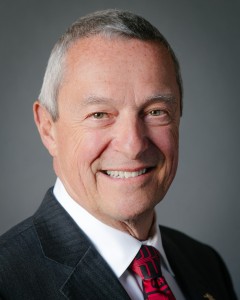
Peter Fassbender, Minister of Community, Sport, Cultural Development and Minister Responsible for Translink
Just after SVO’s August issue press-time the BC Liberal government announced a cabinet shuffle that sees, among several changes, Coralee Oakes moved to Small Business, Red Tape, and liquor, and former Education Minister (and former mayor of Langley) Peter Fassbender take over the Community, Sport and Cultural Development – and Translink – file.
This shift comes on the heels of Coralee Oakes meeting with most of the mayors, councils, and CAOs from the Capital Region. It also comes on the heels of SVO releasing an online story of Oakes’ meeting with the Victoria-Swan Lake BC Liberals and Amalgamation Yes guests at a breakfast meeting. In this meeting Oakes talks of her long-time vision of amalgamating the Capital Region, and what that might look like.
Why the shuffle? Was it something that Oakes did wrong, or Fassbender does right – and if so, what, and how will it affect Saanich and the Peninsula? Whatever the ministerial change means, the written mandate from Premier Clark to Fassbender on July 30 is the same as her written mandate to Oakes on June 12 – “Develop and present options to Cabinet on potential processes under which local governments could either amalgamate or integrate service delivery by June 30, 2016.”
SVO‘s printed August issue leads with the following update to our on-line story. SVO will continue to update the story as details and analysis become available.
July 29, 2015 – Community, Sport and Cultural Development Minister Coralee Oakes met last month with some of the councils from around the CRD, after having invited all to separate 30-minute meetings. Many of the Capital Region’s mayors and councillors emerged hopeful of seeing a robust and unbiased investigation into governance.
Following Saanich’s meeting, with the Minister Councillor Fred Haynes commented, “An important observation I had was that the word ‘amalgamation’ did not appear in any process the minister described, or in the outcomes. Instead the emphasis was on the need for very good data, a very good and transparent process of public education such that the data can be understood, and that this leads to the opportunity for the people of the region to eventually have their say through a referendum.”
""
Saanich Councillor Colin Plant repeated comments made by the minister including her saying that “there is no pre-determined outcome,” and that “improved governance, and not amalgamation, is the goal.” Plant felt that, “People’s concerns were allayed by the Minister’s comments.”
View Royal’s outspoken Mayor David Screech said, ‘The minister is interested in discussing governance issues in general as opposed to doing an amalgamation study.”
But are they Minister Coralee Oakes’ Peter Fassbender’s visions, or Premier Clark’s
by Michele Murphy
If an open, honest investigation into local governance in the Capital Region is what you’re looking for, this all sounds hopeful. But a recording of a private March 10, 2015 breakfast meeting where Minister Oakes spoke to a gathering organized by the BC Liberal Victoria-Swan Lake Riding Association tells a different story.A link to a recording of the meeting is found on the Amalgamation Yes website. The recording has Oakes addressing the amalgamation-friendly crowd candidly and openly, making references to her long-time dream of amalgamating Victoria.
Oakes opened the presentation recalling a “blue-sky” Liberal caucus event where the premier [Clark] asks her caucus to put on the table something that they really, really want to do. Minister Oakes picks the amalgamation of Victoria as her “blue-sky” vision, saying that she thinks that it’s time. She says that she spent 14 years working with the BC Chamber of Commerce. She explained that the Chamber has a key policy around the amalgamation of Victoria communities.
Oakes, a self-proclaimed process-person, lays out the path ahead. Directly after what she refers to as a successful referendum result, she says, “The first step is that local governments have to ask us to do a governance study.” And for the municipalities that won’t come forward Oakes says that the Province can, “do supportive work, reminding the local governments what the citizens have asked for.” Oakes cautions that, “amalgamation is going to be a long process, and we might need to look at phased-in approach.”
A member of the audience suggests that it would be wise to call the mayors together for a conversation. In response Oakes says that she “runs into this little challenge around respecting local governments’ autonomy. That’s the one challenge that I always have, because if we didn’t have that one little piece, man what I could do.” Her audience laughs.
Oakes suggests that no one wants to be left out of conversations. If they can get two or three local mayors, the other communities will follow. “What I am saying is I have a letter from the city of Victoria saying they want to have a meeting with the minister. We are going to send that letter out, which is going to drive the conversation, “ says Oakes, adding, “I guarantee you, if I say that I’m going to sit down with Victoria to talk about this, other people are going to want to come and be part of that conversation.”
Oakes went on to say that she wants to look at what type of grassroots processes they use, citing pros and cons on the size of the grassroots movement. Is it a citizen-led conversation, and if it is, the conversation would then need to invite the Province into the conversation.
The minister assures the audience that resources are available. The money has been put aside for the governance study.
So why the disconnect? Why is Oakes now speaking of improved governance, and not amalgamation? Could it be that Oakes has changed her blue-sky vision? Or is it something else?
The probable answer to the language softening is found just 18 minutes into her presentation to the breakfast group when Oakes says, “As we come forward I think you’re going to see us use different language. You’re going to see us use language like restructuring. You’re going to see shared services. I didn’t want to come into the room and have that language and then you think that I’m trying to steer us away from what was on the ballot.”
Victoria’s Mayor Lisa Helps, met with the minister on July 14th, but has been rather reluctant to use any language at all around the meeting. Helps met with Oakes in private, without her council, and except for a re-tweet of Oakes’ Twitter comment, “Great meeting with @lisahelps. Lots of optimism and ideas!,” Mayor Helps has yet to respond to SVO’s request for comment.
While Oakes may have changed the language, it seems that Premier Clark didn’t get the memo. In the Premier’s June 12 annual mandate letter to Oakes she stated that the minister was to, “Develop and present options to Cabinet on potential processes under which local governments could either amalgamate or integrate service delivery by June 30, 2016.”
Mayors and Councillors from Central Saanich, North Saanich, and Sidney met separately with Community Minister Coralee Oakes on Tuesday, July 14. SVO asked mayors and councils from Saanich and the Peninsula for comment on the Minister’s March 10th presentation providing a transcript of the event.
Long-time Saanich Councillor Vicki Sanders said that had she heard the recording before council met with Minister Oakes she would have had a clearer understanding of the use of the words governance and integration rather than amalgamation. Sanders says, “I am now aware that the intention is to encourage amalgamation.”
North Saanich Councillor Celia Stock felt that the Minister’s March 10th comments were unclear. Stocks asks, “Is her blue sky vision about amalgamation or better governance? Does she think that better governance at the municipal level will be attained by amalgamation?”
One thing Oakes has said that is clear, democracy is difficult.
-30-
For more info:
Coralee Oakes, Minister of Community, Sport & Cultural Development on Amalgamation at March 10, 2015 or on DropBox
Peter Fassbender Mandate Letter, July 30, 2015
Coralee Oakes Annual Mandate Letter, June 12, 2015
More stories on amalgamation and governance on SVO – HERE.

Major Development Downsized
Aragon Properties Cordova Bay project reduced to six storeys
by Roger Stonebanks, citizen journalist
A contentious 12-storey condo proposed for the former Trio property in Cordova Bay has been reduced to six storeys by owner/developer Aragon Properties.
As well, the number of dwelling units planned for the 26-acre (10.6 hectare) site at 755 Cordova Bay Road has been reduced to 385 from 443 or 13 per cent, David Roppel, Aragon’s director of planning and development, told Saanich Voice Online.
The 12-storey building and the number of dwelling units were raised as objections at a public input meeting organized by Aragon on May 30, 2015, in Cordova Bay.
Neil Findlow, Senior Planner at the District of Saanich, told Saanich Voice Online that Aragon Properties has provided “a preliminary submission. Planning is reviewing the submission and will advise Aragon about possible process and additional information that may be required for a formal application (for rezoning). A formal application is expected in the late summer.”
Findlow said that discussions are on-going with Saanich staff about site servicing “and in particular, options to address sewerage flow from the site which would exceed the capacity of seven litres per second. The current proposal would generate a flow of +/- 15 litres per second and would require upgrades to the downstream sewerage system at Aragon’s expense. Aragon is in discussion with our Engineering Department about possible options including on-site detention. Saanich made Aragon aware of the sewerage flow limitation before it purchased the property.”
Findlow added that Aragon “has stated that updates of the geotechnical reports and a Traffic Impact Analysis are currently being prepared and will form part of the formal submission.”
No dollar figure has been put on the proposed development which comprises a mix of housing types including row houses, single-family houses and taller buildings between three and six storeys, arranged in three terraces as well as 2,500 square metres (26,909 square feet) of commercial space. Aragon bought the property last year from the McLaren family for $6.1 million.
The site is one of the last significant properties within the Saanich Urban Containment Boundary and the Sewer Service Area.
-30-
For more information: 755 Cordova Bay Road
Contact David Roppel at Aragon Properties – [email protected]
Neil Findlow at Saanich Planning – [email protected]
More on this story:
Major Housing Development Planned For Cordova Bay (May 31, 2015)
Encouraging the Community Early, and Often (May 3, 2015)

